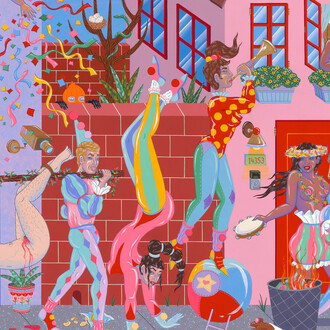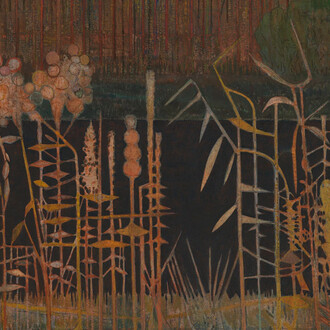Cobra is frequently remembered as a style of Northern European painting—merging figuration and abstraction—that emerged in the traumatic wake of World War II. In an American academic context, Cobra’s importance is often measured through the narrow filter of their eponymous journal, which featured the writings of Constant, Asger Jorn, Christian Dotremont, and other members. The exhibition seeks to rectify these reductive understandings of the movement in the United States by exposing a layered and multi-tentacled avant-garde movement, spanning three decades and many more countries than just Denmark, Belgium, and the Netherlands.
The exhibition will begin in New York with a re-examination of the artist collective Helhesten (The Hell Horse), the precursor to Cobra, which Jorn founded in 1941 in the midst of Nazi-occupied Denmark. This group of politically committed, progressive artists seized the Nordic mythical figure of the “hell horse” as their emblem. Jorn, along with artists such as Sonja Ferlov Mancoba, Henry Heerup, Egill Jacobsen, and Carl-Henning Pedersen among others, shared an interest in an exploration of ancient folk art, populist art forms, and the legacy of Surrealism in defiance of their anti-Modernist German occupiers. With Jorn’s federating charisma, the Helhesten group spawned the form l seeds that would later animate Cobra. Art historian Kerry Greaves has recently written of Helhesten, “they provide a crucial link between the historical and post-war avant-garde, and without [Helhesten] there would have been no Cobra.” The selection of Helhesten paintings, sculptures, drawings, and other ephemera will be one of the few occasions that these Danish artists have been recognized in an American exhibition context.
Moving beyond the formative years of Helhesten, the exhibition will trace the confluence of Jorn’s collective with other groups, such as the Dutch Experimental Group and the Belgian Revolutionary Surrealists, to eventually form Cobra from 1948 to 1951. Unified by a keen interest in Marxism, Cobra saw itself as a “red international” that rejected Western aesthetics, embraced spontaneity, collaborative work methods, and drew inspiration from children’s drawings, the art of the insane, and primitivism. The exhibition will feature a re-reading of the key protagonists of Cobra—Pierre Alechinsky, Karel Appel, Constant, Christian Dotremont, and Jorn—as well as foreground lesser-known figures beyond the home countries for which the movement is named. In particular, artists such as Ernest Mancoba (a South African artist who had settled in Denmark and later Paris and was married to Sonja Ferlov Mancoba, a sculptor and key figure in the Helhesten group), and Shinkichi Tajiri (a Japanese-American sculptor and painter who eventually settled in the Netherlands after serving in WWII).
The latter half of the exhibition, taking place in Los Angeles, will cast its view beyond the formal ending of Cobra in 1951 by following the political activities and aesthetic experiments of Asger Jorn through the 1950s to his death in 1973. Including later “modification paintings” (interventions or détournements on anonymous paintings bought in flea markets), abstract paintings utilizing unconventional materials, and experimentations with ceramics and textiles, Jorn’s later output shows the fruition of many of the ideas that first germinated in the Cobra period. While maintaining his exchange with Cobra artists, Jorn also widened his circle of collaboration and exchange with members of the Italian neo-avant-garde, such as Enrico Baj and Lucio Fontana, as well as artists such as Jean Dubuffet.
The Avant-Garde Won’t Give Up will argue that Cobra did not end with the formal disbanding of the group in 1951. In fact, Cobra’s ideas and aesthetics were only realized in the two decades that followed—blossoming into a relentless multinational, literary, political, and radically polymath exploration of numerous artistic media. In tracing this complex web of artists and ideas, the history that unfolds insists upon a more complex genealogy of one of the least understood, yet important movements of the last sixty years. This broad understanding of Cobra artists’ artistic and discursive output reveals them to be dynamic figures, whose legacy continues to impact the art of today. To this end, the exhibition in Los Angeles will propose a series of historical and contemporary juxtapositions by a range of living artists. This transgenerational presentation will underscore the urgency of this reexamination of Cobra—by viewing the movement’s groundbreaking experiments and ideas through the lens of the present day. Among artists in the New York exhibition are Pierre Alechinsky, Else Alfelt, Karel Appel, Eugène Brands, Constant, Corneille, Christian Dotremont, Sonja Ferlov Mancoba, Henry Heerup, Egill Jacobsen, Asger Jorn, Ernest Mancoba, Carl-Henning Pedersen, Shinkichi Tajiri, and Raoul Ubac. The Los Angeles exhibition will present work by the core Cobra group from the New York exhibition as well as works by Enrico Baj, Corneille, Mark Flood, Magdalena Suarez Frimkess, Gelatin, Mark Grotjahn, Jacqueline de Jong, Friedrich Kunath, Eddie Martinez, Bjarne Melgaard, Jon Pylypchuk, Reinhoud, Julian Schnabel, Walasse Ting, and more (list of participating artists in formation).
Bringing together rarely exhibited works by several artists who have not been seen in the US for decades, the realization of this exhibition has drawn upon the close, generous collaboration of numerous Cobra artists, estates, families, and private collections. The Avant-Garde Won’t Give Up also pays homage to the visionary work of the Lefebre Gallery. Established in New York in 1960 by John Lefebre and closed in 1986, this trailblazing gallery was one of the few to support and promote the Cobra movement in America.


![Corneille Fable païenne, 1949 [Pagan Fable]
Oil on canvas, 31 1/2 x 27 3/8 inches, Collection Cobra Museum of Modern Art, Amstelveen,
Purchased with the support of de BankGiro Loterij and the Municipality of Amstelveen © 2015 Artists Rights Society (ARS), New York / ADAGP, Paris
Courtesy of Blum & Poe](http://media.meer.com/attachments/503832e8f21be6f39062f19c3174a9d47885101e/store/fill/410/615/ff2fbb4eb8017bfb3f3aa89bd181a52171317d82ae10253152005db0707b/Corneille-Fable-paienne-1949-Pagan-Fable-Oil-on-canvas-31-1-slash-2-x-27-3-slash-8-inches.jpg)













